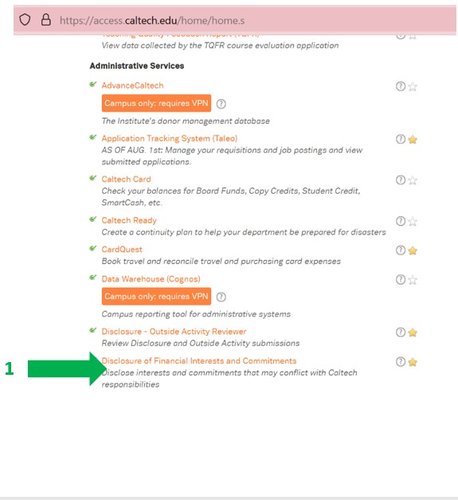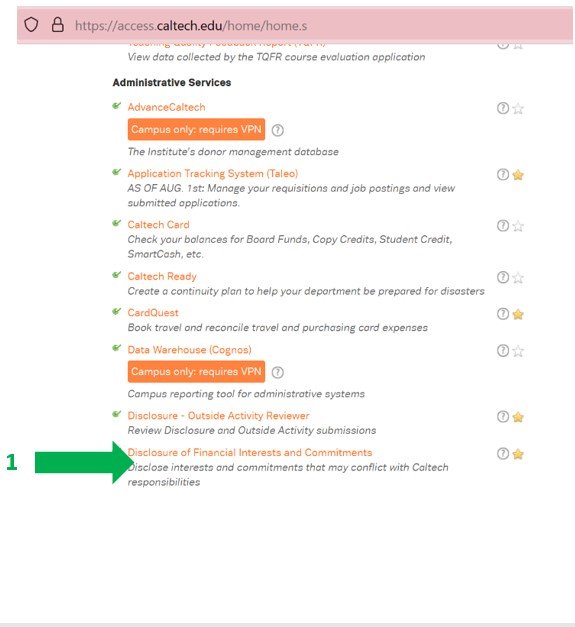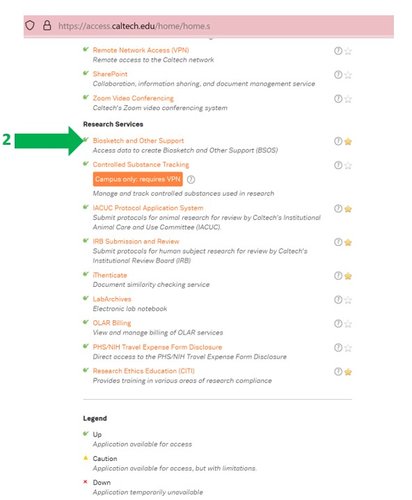Recap of BBE Presentation on BSOS
On April 5, 2022, the Offices of Sponsored Research, Research Compliance and General Counsel presented a refresher course on NIH Biosketch and Other Support Requirements and provided training for use of the new Biosketch and Other Support (BSOS) application available on ACCESS.Caltech.edu. Highlights and a link to the presentation and slides are found on this webpage. Shortcuts to the various sections are provided here:
April 2022 Slides and Presentation
Mapping BSOS to NIH Disclosure Requirements
IMPORTANT! DESIGNATE A VIEWER
FACULTY and Other Researchers (Postdocs and Research Staff):
So that Grants Management and Administration can help you assemble your Biosketch and Other Support, please make sure you have done the following:
(1) Complete your annual Disclosure of Financial Interests and Commitments
(2) DESIGNATE a Viewer:
Designate a Viewer
View (A)
View (B)
- Upon opening the application, you will see a button labeled "Designated Viewer" either with the full view of your information (A) or on a dashboard (B).
- Select "Designated Viewer." A pop-up window will open. Please designate at least your Grant Manager or another Administrative Personnel who helps you assemble your Biosketch and Other Support documentation. Postdocs and Research Staff should also designate their PI/Advisor. You may designate anyone you wish at Caltech.
- The Offices of Sponsored Research, Research Compliance and General Counsel, as well as your Division Operations Officer can view your BSOS Report by default. Any additional personnel you wish to have access must be designated by you. (See Designating Viewers) The column labeled "People whom you have designated" is a list of those individuals whom you have designated.
User Guide and Presentation:
OTHER TOOLS
Mapping BSOS to NIH Disclosure Requirements (A Checklist):
| Consideration |
BSOS Section |
Biosketch | OS/In-Kind |
|---|---|---|---|
| Outside Affiliations & Appointments - Paid & Unpaid. This includes unpaid Appointments such as "guest", "adjunct", "honorary", or "visitor" titles. |
• Biosketch • Other Support: DFIC |
X | X |
| Outside Research Roles – Any activity with another institution where you are identified as the PI, Co-PI, investigator, or other key personnel on a project (proposed or awarded. (Do not include proposals or awards processed through Caltech or Caltech subcontracts) |
• Biosketch • Other Support: DFIC |
X | X |
| Outside Programs & Activities - Non-Caltech program or activity that provides you with compensation, research or office facilities, sponsored or reimbursed travel, honorary funding, or any type of benefit in exchange for teaching or mentoring students, performing research for another institution, or publishing research results naming your affiliation at the other institution |
• Other Support: DFIC • Other Support: Other and In-kind (Editable) |
X | |
| Personal Financial Interest - Have you received any Personal Financial Interest (e.g., salary, consulting fees, stock/stock options, honoraria, gifts, or sponsored or reimbursed travel) from a Caltech entity that will be used to support your Caltech research endeavors? | • Other Support: DFIC | X | |
|
In-Kind - Any "in-kind" resources in support of your research endeavors that are obtained through a collaboration, appointment, or relationship with an outside institution, organization, or company ("Entity") In-kind |
• Other Support: DFIC • Other Support: Other and In-kind (Editable) |
X | |
| PD and Students - Any Caltech postdoctoral fellows or students involved in research for your lab supported in full or in part by any external (non-Caltech) organization, institution, company, or government ("Entity") including fellowships |
• Other Support: Externally Funded Postdoctoral Fellows • Other Support: Other and In-Kind (Editable) |
X | |
| Visitors - Any visiting postdoctoral fellows, visiting students, or visiting scholars involved in research in your lab who are paid directly, in full or in part, by any Caltech organization, institution, company or government ("Entity") |
• Other Support: Externally Funded Postdoctoral Fellows • Other Support: Other and In-Kind (Editable) |
X | |
| “Traditional” Other Support – Grants, Contracts, Gifts used for Research, Postdoctoral Fellowships |
• Other Support: Caltech Grants, Contracts, Gifts • Other Support: Federal Awards from which you have been paid |
X |
Collaboration Spectrum and Reporting to NIH:
Scientific collaborations can range from general discourse with a colleague at a scientific conference to sharing resources and ideas to designing and performing experiments together. Detailed federal guidance on which collaborations to report as "in-kind" or "other support" is scant. Nonetheless, research investigators are required to report their collaborators in grant applications and annual progress reports. The matrix found at this LINK sets forth the spectrum of collaboration and gives researchers a basis for considering which activities and relationships to report to NIH.
FAQ
There were a few questions that were asked during the presentation with regard to In-Kind Support and Other Support. We are providing the following guidance to assist faculty in responding to NIH's requirements for disclosing Other Support. Please do not include this text or otherwise characterize these interpretations in your Other Support submissions, as doing so is more likely to draw attention to your submissions. If you receive questions from NIH about what you have or have not included in your Other Support, please feel free to contact Ann Martin, Grace Fisher-Adams or David Mayo so that they can help you with a response back to NIH.
Questions about Other Support and In-Kind:
BBE QUESTION 1: What should be considered a "High-Value Materials" disclosable as Other Support?
NIH provides that only materials provided within the last three years which are still in use must be disclosed as Other Support (FAQ 7 In-Kind Contributions). NIH also provides that high-value materials that are not freely available (e.g. biologics, chemical, model systems, technology, etc.) are included in other support, but does not provide a definition of such materials.
Caltech Guidance: As a threshold, if there are facilities, equipment, and other resources or contributions that are provided at no cost from an external source and these resources are uniquely available (i.e., not widely available to the scientific community) to you for your research and not to the entire Caltech community, these may be Other Support. If these same materials can be purchased commercially, they are not uniquely available. At that juncture, the researcher should consider the monetary value. $5000 is likely a reasonable threshold for "high-value" since it is the value NIH uses to define a personal significant financial interest. When trying to determine what value to report, NIH expects you to estimate in-kind value to the best of your professional judgment, using comparable contributions, estimated averages and fair-market rates (FAQ 9 In-Kind Contributions).
BBE QUESTION 2: When should a Collaboration be reported as Other Support?
Collaborations as Other Support: NIH provides some guidance in this area, and Caltech has further focused that guidance in the Collaboration Spectrum tool, (also referenced above).
Generally, you should disclose collaborators as Other Support when you have received data, materials, reagents, results, etc. from them, that benefit or benefitted your research or that led to a publication where you gave co-authorship or acknowledgment to the collaborator, or if your collaborator visited your lab to perform experiments.
BBE QUESTION 3: When should Co-authors be reported as Other Support?
Publications/Co-authors as Other Support: Again provides some guidance in this area, and Caltech has further focused that guidance in the Collaboration Spectrum tool, (also referenced above)
Publications and co-authors as Other Support:
Generally, you should disclose co-authors as Other Support where the co-author performed experiments in your lab, or their contribution to the paper directly benefited your lab's research that is reported in the paper, or they contributed a key resource to your lab's research reported in the paper, or they performed extensive data analysis on your lab's research reported in the paper.
We recommend that you review the Collaboration Spectrum as it provides various collaboration scenarios that we believe will assist you in navigating what to include in your Other Support submissions.








